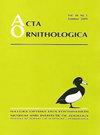Seed Selection by Crossbills Loxia spp. within Cones of Scots Pine Pinus sylvestris
IF 1.3
4区 生物学
Q3 ORNITHOLOGY
引用次数: 0
Abstract
Abstract. Why foraging animals sometimes leave patches before consuming all available food items is a key question in behavioural ecology. Abandoning some food would appear to be disadvantageous, yet optimal foraging theory demonstrates that this sometimes optimises energy intake rates. Crossbills Loxia are specialist avian granivores that forage on seeds within the cones of many species of conifer in the northern hemisphere. They often abandon a few seeds within cones they have fed upon. We assessed whether seeds left within Scots Pine Pinus sylvestris cones by foraging crossbills were of lower mass or in particular positions within the cone. Crossbills foraged on long cones which have more seeds per cone and heavier seeds, but avoided the longest cones, which typically have thicker scales that require more energy to open. Cones dropped by foraging crossbills contained over four seeds per cone, representing approximately one fifth of those originally present. Crossbills left mostly small or empty seeds (< 2 mg), whereas the average mass of seeds from intact cones sampled from the canopy was 3.6 mg. Infrequently, single seeds of high mass (> 4 mg) were left behind, perhaps mistakenly overlooked during foraging. Such apparent preferential foraging on heavier seeds is probably advantageous, because of the higher energy reward per seed. To directly discriminate between seeds prior to extraction would reduce energy expenditure in foraging. This raises the question of how crossbills could attain this favourable outcome. While cones scales were closed an external cue would be required. After cone scale dehiscence, seeds would be visible to crossbills, allowing them to discriminate visually among seeds and selectively extract heavier seeds, leaving lighter seeds behind within the cone. Dropping cones when few seeds are encountered or as seed mass declines towards the distal scales could be additional components of crossbill foraging strategy.苏格兰松松球果内杂交蚤的种子选择
摘要为什么觅食动物有时会在吃掉所有可用的食物之前留下斑块,这是行为生态学中的一个关键问题。放弃一些食物似乎是不利的,但最佳觅食理论表明,这有时会优化能量摄入率。Crossbills Loxia是一种专门的鸟类食肉动物,以北半球许多针叶树球果内的种子为食。它们经常把一些种子丢弃在它们吃过的球果里。我们评估了通过觅食杂交留在苏格兰松樟子松球果中的种子是否质量较低或在球果内的特定位置。Crossbills在长球果上觅食,每个球果有更多的种子和更重的种子,但避开了最长的球果,后者通常有更厚的鳞片,需要更多的能量才能打开。觅食杂交种投下的球果每个球果含有四颗以上的种子,约占原始种子的五分之一。Crossbills留下的大多是小种子或空种子(<2 mg),而从树冠上取样的完整球果的平均种子质量为3.6 mg。很少有高质量(>4 mg)的单个种子被留下,可能在觅食过程中被错误地忽略了。在较重的种子上进行这种明显的优先觅食可能是有利的,因为每颗种子的能量回报更高。在提取之前直接区分种子将减少觅食的能量消耗。这就提出了一个问题,即交叉疫苗如何才能获得这种有利的结果。当锥体天平关闭时,需要一个外部提示。球果规模开裂后,杂交种可以看到种子,使它们能够在视觉上区分种子,并选择性地提取较重的种子,将较轻的种子留在球果内。当遇到很少的种子或种子质量向远端鳞片下降时,掉落球果可能是杂交种觅食策略的额外组成部分。
本文章由计算机程序翻译,如有差异,请以英文原文为准。
求助全文
约1分钟内获得全文
求助全文
来源期刊

Acta Ornithologica
生物-鸟类学
CiteScore
2.10
自引率
0.00%
发文量
14
审稿时长
>12 weeks
期刊介绍:
Publishes scientific papers (original research reports, reviews, short notes, etc.) and announcements from all fields of ornithology. All manuscripts are peer-reviewed.
Established in 1933 as Acta Ornithologica Musei Zoologici Polonici, since 1953 continued under the present title.
Published twice a year by the Natura Optima Dux Foundation under the auspices of the Museum and Institute of Zoology, Polish Academy of Sciences.
 求助内容:
求助内容: 应助结果提醒方式:
应助结果提醒方式:


